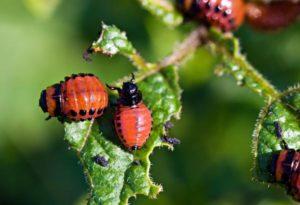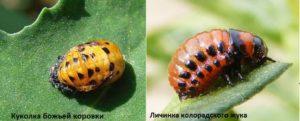Voracious larvae of the Colorado potato beetle
An adult Colorado potato beetle is very difficult to confuse with any other insect. Its bright striped elytra are familiar to every summer resident and gardener. But the larvae of this pest can be very similar to the pupae of another useful bug, but at the same time, some of them are of great benefit to the plants on the site, while others cause tremendous damage.
Content
What do Colorado potato beetle larvae look like?
The larvae of the striped pest are somewhat larger than the adults. The length of their body can reach 1,5-1,6 cm. On the sides of the body of the larva there are two rows of rounded black spots. The head of the larva is painted black, and the color of the body changes in the process of growing up.
The youngest larvae are painted in a dark, brownish color, and closer to pupation they acquire a light pink or red-orange color. This is due to the fact that in the process of eating the green parts of the potato, the pigment carotene accumulates in their body, which paints the larvae in a bright color.
Larval development cycle
The appearance of larvae into the world occurs approximately 1-2 weeks after the eggs were laid. The entire process of maturation of the larvae is divided into 4 stages, between which molting occurs.
Larvae of the first and second instars usually do not move between plants and stay in small groups. Their diet consists exclusively of soft parts of the leaves, since they are not yet able to cope with thick veins and stems.
Older individuals of the 3rd and 4th instars begin to feed more intensively and eat even the hard parts of plants. At these stages, the larvae begin to actively move around the plant and can even go to neighboring bushes in search of food.
After the larvae have accumulated enough nutrients, they burrow underground to pupate. On average, the life span of the Colorado potato beetle larvae, from the moment they hatch from the egg to pupation, is 15-20 days.
Diet of Colorado beetle larvae
The larvae of the Colorado potato beetle feed on the same plants as the adults. Their diet consists of plants such as:
- potatoes;
- tomatoes;
- eggplants;
- Bulgarian pepper;
- other plants from the nightshade family.
Juveniles can be much more voracious than adults. This is due to the preparation of the larvae for pupation, since during this period the insects try to accumulate the maximum amount of nutrients.
Methods of dealing with the larvae of the Colorado potato beetle
Almost all methods of dealing with the Colorado potato beetle are aimed at the destruction of both adults and larvae. At the same time, it is easier to deal with the latter. Larvae are a little easier to get rid of due to their inability to fly and greater vulnerability to natural enemies.
The most popular methods for the destruction of the larvae of the Colorado potato beetle are:
- manual collection of insects;
- spraying with insecticides;
- processing folk remedies;
- attraction to the site of animals feeding on the larvae of "colorados".
The similarity of the larva of the Colorado potato beetle and the pupa of a ladybug
Despite the fact that these are two completely different types of insects that are at different stages of development, they are very often confused with each other. Their size, body shape and color are very similar and differences can only be noticed upon closer examination.
The ability to distinguish a pest from a "solar bug" is very important for land owners. Unlike the Colorado potato beetle, the ladybug brings great benefits - it destroys aphid populations, which are also a dangerous pest.
You can recognize the pupa of a beneficial insect by the following signs:
- unlike the larva, the pupa is immobile;
- spots on the body of the pupa are located randomly throughout the body and are painted in different colors;
- ladybug pupae are always firmly glued to the surface of the plant.
Conclusion
Farmers who want to grow potatoes on their plot should know their enemy “by sight” and get to know the young “Colorados” better. They are no less dangerous pests than adults, and their presence on the site can cause serious damage to plants.
Previous


